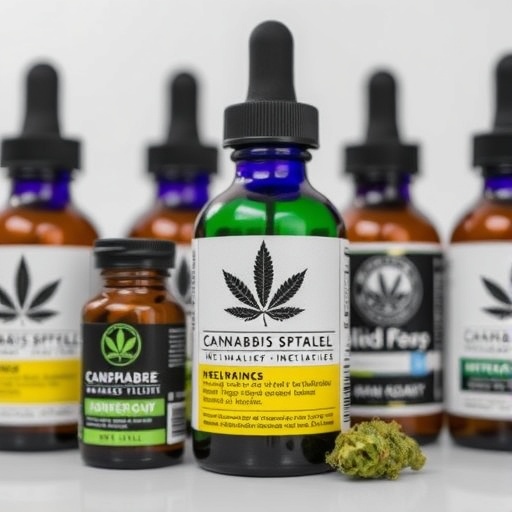A recent investigation led by clinical psychiatry experts at Columbia University has unveiled alarming discrepancies in the labeling and packaging of cannabis products sold by unlicensed retailers across New York State. This groundbreaking research exposes a significant void in regulatory oversight, emphasizing that many unlicensed cannabis products lack the mandatory health and safety labels required by law, and shockingly, their packaging often mimics those designed to captivate and appeal to underage youth. The findings highlight crucial public health concerns tied to the unregulated cannabis market proliferating alongside legalized sales.
New York State law strictly prohibits the purchase of cannabis products from unlicensed vendors and forbids sales to individuals under the age of 21. Despite these prohibitions, the study reveals that the unregulated marketplace continues to thrive, offering products that evade adherence to vital safety disclosures. Licensed retailers, contrastingly, comply with rigorous standards mandating transparency concerning potency, expiration, dosing information, and health warnings intended to safeguard consumers. This study’s evidence underscores the urgency of legislative and enforcement measures to bridge the regulatory divide between licensed and unlicensed markets.
Ryan Sultán, assistant professor of clinical psychiatry at Columbia University Vagelos College of Physicians and Surgeons and a lead investigator, points to the critical risks posed by this gap in regulation: “Our research indicates a pervasive deficit in product safety compliance that jeopardizes consumer well-being. Coordinated efforts between state and federal agencies are imperative to enforce clear labeling standards and to curtail deceptive packaging tactics that undermine informed consumption.” His insights echo broader concerns about the intersection of public health and cannabis commercialization in rapidly evolving legal landscapes.
.adsslot_qk8WJhd3OF{ width:728px !important; height:90px !important; }
@media (max-width:1199px) { .adsslot_qk8WJhd3OF{ width:468px !important; height:60px !important; } }
@media (max-width:767px) { .adsslot_qk8WJhd3OF{ width:320px !important; height:50px !important; } }
ADVERTISEMENT
In the context of New York’s regulated cannabis market, licensed retailers are required to provide comprehensive labeling that details THC potency—a psychoactive compound directly influencing intoxication levels—and clearly state product quality, usage instructions including ‘use-by’ dates, and standardized health warnings. The purpose is to facilitate safe, responsible use and minimize potential adverse health effects linked to improper dosing or exposure to unverified substances. By contrast, the study reveals that products from unlicensed sources frequently omit these critical disclosures, creating an opaque consumer environment.
Moreover, licensees are legally barred from marketing cannabis products with medical claims or targeting minors. Yet, the researchers observed widespread dissemination of products featuring vibrant, playful designs, cartoon imagery, and child-appealing fonts, particularly among those sold in unregulated venues. The packaging aesthetics, often designed to attract younger demographics, raise serious ethical and regulatory concerns regarding youth exposure and initiation risks. This finding is troubling given the demonstrated susceptibility of adolescent brains to the neuropsychological impacts arising from early cannabis use.
The rapid expansion of legal cannabis markets has inadvertently catalyzed a parallel surge in unlicensed retailers, who operate with less oversight and accountability. These merchants frequently offer cannabis products that bypass quality assurance protocols, raising the specter of consumption-related hazards ranging from excessive THC dosage to contamination by harmful substances. The proliferation of unregulated cannabis necessitates vigilant surveillance and public education to mitigate the consequences of unverified product consumption.
The Columbia-led study employed a comparative analysis of 88 cannabis products procured from both licensed and unlicensed retailers within New York City. The stark contrasts documented illuminated a grim reality: only approximately 3% of unlicensed products manifested the full spectrum of six mandated New York State health warnings and safety features, whereas nearly 50% of licensed items conformed to these requirements. Such disparities underscore the systemic shortcomings of unlicensed channels in delivering safe, transparent cannabis products to consumers.
An additional layer of concern lies in the prevalent mislabeling observed among unlicensed products. These items frequently displayed official-looking symbols appropriated from other states’ regulatory systems—California’s universal cannabis symbol being an example—or else incorporated irrelevant warnings typical to edible cannabis products on non-edible items. This form of deceptive labeling not only confuses consumers but also undermines interstate regulatory harmonization and consumer trust.
Timothy Becker, the study’s lead author and current assistant professor of clinical psychiatry at Weill Cornell Medicine, accentuates these dangers: “The absence of clear, accurate labels significantly elevates the risk of unintended consumption effects. Consumers are often unaware of the true potency and potential hazards associated with these unregulated products, leading to documented cases of acute toxicity and longer-term health complications.” Becker’s perspective situates the labeling issue within a broader discourse on cannabis safety and consumer protection.
Another revealing dimension from the study is the packaging styles utilized by both licensed and unlicensed sellers. While nearly all sampled products employed bright, multicolored designs and playful fonts—elements that could inadvertently appeal to minors—about 25% of unlicensed products prominently featured cartoon characters or other graphic elements explicitly designed to attract children and teenagers. Licensed products avoided such imagery, highlighting adherence to stricter marketing guidelines in the regulated sector.
Sultán voices particular alarm over this trend, stating, “The prevalence of child-targeted packaging in the unlicensed market is a deeply concerning public health issue. At a time when cannabis consumption among adolescents is linked to cognitive and behavioral risks, it is vital that packaging does not serve as a gateway appeal to this vulnerable group.” These concerns amplify calls for tighter restrictions on cannabis marketing and packaging content nationwide.
The data and analyses presented in this research articulate an urgent policy challenge: balancing the benefits of cannabis legalization and commercialization with the imperative to protect public health, particularly among underage groups and inexperienced users. The revelations of regulatory laxity within unlicensed sectors call for enhanced enforcement mechanisms and potentially, technological innovations such as blockchain tracking or tamper-evident packaging to ensure comprehensive accountability.
Published in the American Journal of Preventive Medicine, the study titled “Labeling of cannabis products from licensed and unlicensed retailers in New York” not only elucidates the current regulatory landscape’s deficiencies but also serves as a clarion call for multi-level interventions. Supported by the National Institutes of Health, this research contributes vital evidence needed to guide policymakers, public health officials, and the cannabis industry toward safer, more transparent product distribution standards.
As cannabis legalization continues to evolve nationwide, the findings stress the importance of robust labeling requirements and packaging regulations that prioritize consumer safety and deny marketing avenues appealing to youth. Without such structured oversight, the expansion of unlicensed cannabis commerce threatens to undercut decades of regulatory progress, potentially exacerbating public health risks and eroding public confidence in cannabis as a legally controlled substance.
Subject of Research: Labeling and packaging compliance disparities between licensed and unlicensed cannabis retailers in New York State.
Article Title: Labeling of cannabis products from licensed and unlicensed retailers in New York
News Publication Date: Not specified
Web References: http://dx.doi.org/10.1016/j.amepre.2025.108000
References: Published in the American Journal of Preventive Medicine, authors Timothy D. Becker, Peter J. Menzi, Mark Olfson, Polina Mosharova, Frances R. Levin, and Ryan S. Sultán
Image Credits: Not specified
Keywords: Cannabis, Cannabis labeling, Cannabis packaging, Cannabis regulation, THC potency, Public health, Unlicensed cannabis retailers
Tags: absence of safety labels cannabiscannabis consumer protection lawscannabis market regulation New Yorkcannabis product safety standardsColumbia University cannabis studyhealth risks of unregulated cannabislegislative measures for cannabis regulationlicensed vs unlicensed cannabispublic health concerns cannabisunderage cannabis marketingunregulated cannabis productsunsafe packaging cannabis





